China plans to rein in heavy metal pollution
by: Reuters: Green Business News, 2011-02-22 12:39:10 UTC
BEIJING (Reuters) - China's environmental protection agency has vowed to curb heavy metal pollution in a bid to cut widespread industrial contaminants like lead that have poisoned children and...
 Shipping Fleet ‘to Cut Emissions in Half’
Shipping Fleet ‘to Cut Emissions in Half’
by: Environmental Leader, 2011-02-22 16:40:19 UTC

 Danish shipping company Maersk Line plans to build a fleet of container ships that it calls the world’s largest and most energy efficient.
Danish shipping company Maersk Line plans to build a fleet of container ships that it calls the world’s largest and most energy efficient.
The Triple E fleet will emit 50 percent less emissions compared to the industry average for vessels operating on the Asia-Europe route, Maersk said. This will come out to CO2 savings of about 2.5 tonnes per container on a oneway trip between Shanghai and Rotterdam.
The line will emit 20 percent less emissions per container moved than the Emma Maersk, currently the world’s largest shipping vessel, Maersk said.
The fleet will also use 35 percent less fuel per container than thousands of ships being delivered to Maersk Line competitors in the next two years, the company said.
Maersk’s new line will achieve the reductions through smaller engines and use of a waste heat recovery system, as well as through economy of scale.
The new ship’s cargo capacity will be 18,000 containers, 16 percent more than that of the Emma Maersk. The Triple-E is 400 meters long, 59 meters wide and 73 meters high.
The Triple E will have a 65-70 MW engine, compared to the Emma Maersk’s 80 MW, achieving an eight percent cut in energy consumption.
The ships use a waste heat recovery system that further reduces fuel consumption by nine percent.
Maersk says the fleet helps it towards its goal of reducing CO2 emissions per container by 25 percent by 2020, from a 2007 baseline.
The Triple-E also derives efficiency from its innovative design, Maersk said, including two “ultra-long stroke” engines and specially optimised hull and bow.
Maersk has signed a contract with Korea’s Daewoo Shipbuilding & Marine Engineering Co. to build ten of the vessels, at a price of $190 million each, with an option for an additional 20. Delivery is scheduled to take place between 2013 and 2015.
“International trade will continue to play a key role in the development of the global economy: but, for the health of the planet, we must continue to reduce our CO2 emissions. It is not only a top priority for us, but also for our customers, who depend on us in their supply chain, and also for a growing number of consumers who base their purchasing decisions on this type of information,” says Eivind Kolding, CEO of Maersk Line.
The company said that all materials used to build the new class will be documented and mapped in a “cradle-to-cradle passport”. When the vessel is retired from service, Maersk will be able to dispose of all its materials through reuse, recycling or other safe methods, the company said.
Maersk is a member of Forum for the Future’s Sustainable Shipping Initiative.
Maersk Line claims that it is the first shipping company to receive independent verification of its CO2 emissions data, vessel by vessel, which it supplies to customers.
Last year Maersk said it had cut fuel consumption on major routes by as much as 30 percent, as well as reduced greenhouse gas emissions by an equal amount, by cutting the top cruising speed of its ships in half over two years.
Videos of the new fleet are available here: http://www.youtube.com/user/Maerskcom.
 The Balancing Act
The Balancing Act
by: Yanko Design, 2011-02-21 08:01:19 UTC
My mother is totally dependent on using a walking stick and still, has moments of pain using it. To make it a more comfortable experience, we have here the Balance Stick. It’s been designed to stand on its own and doesn’t fall over if you don’t lean it up against the wall – always at the ready to so your loved ones don’t have to pick it up.
The Balance Stick is a 2011 iF concept design entry.
Designers: Cheng-Tsung Feng & Yu-Ting Cheng
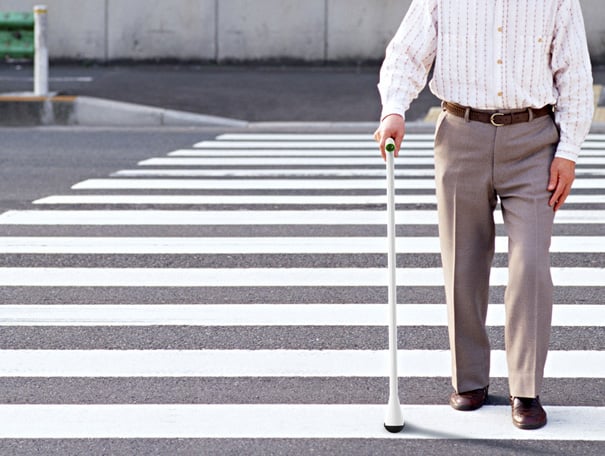
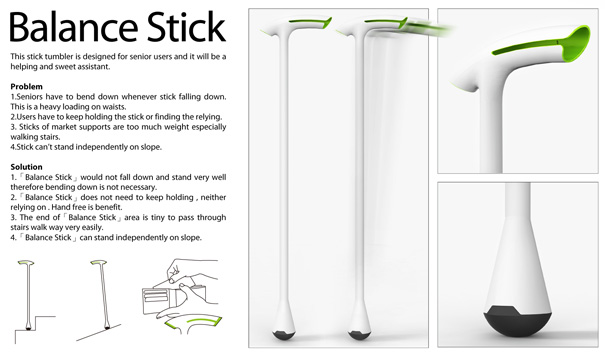
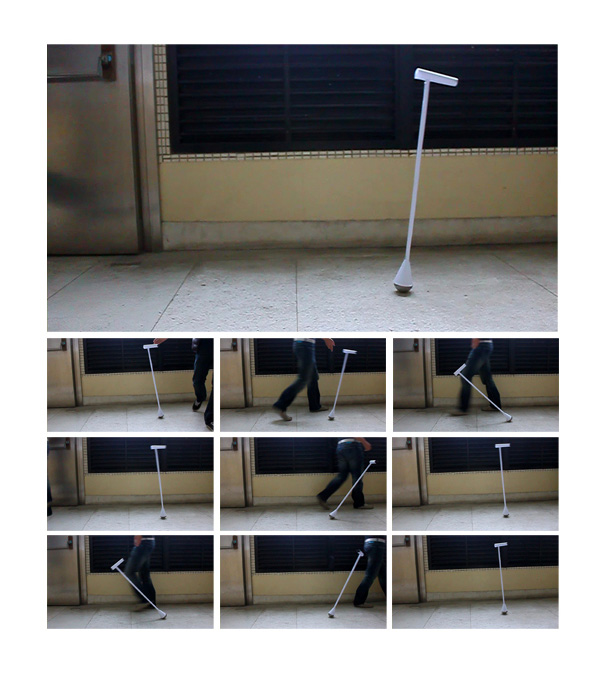
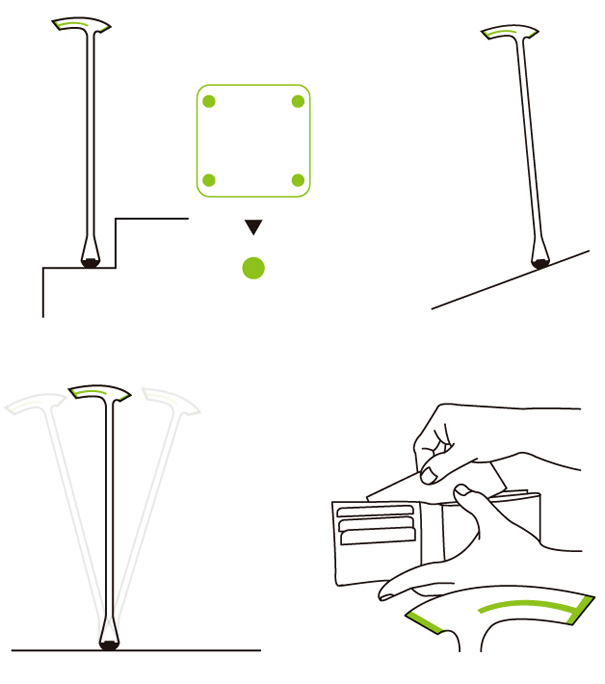
----------
Yanko Design
Timeless Designs - Explore wonderful concepts from around the world!
Yanko Design Store - We are about more than just concepts. See what's hot at the YD Store!
dB Cases provide simple solution for upping iPhone audio
by: Gizmag Emerging Technology Magazine, 2011-02-18 04:02:27 UTC

If you’re looking to give your
iPhone 4 a boost in the speaker department there’s no shortage of docks on the market to do the job. As portable as many of these solutions may be, they can’t compare to the exceptionally simple and seemingly effective solution hit upon by audio enthusiast Rudy James. Looking to squeeze out every last decibel from his iPhone, James decided to create a protective case that directs the sound from the iPhone 4’s down-facing speakers out towards the user. ..
Continue Reading
dB Cases provide simple solution for upping iPhone audioTags: Acoustic,
iPad,
iPhone 4,
iPod touch
Related Articles:


 The Triple-E Maersk container ship will be the world's largest ship and the most efficient
The Triple-E Maersk container ship will be the world's largest ship and the most efficient
by: Gizmag Emerging Technology Magazine, 2011-02-21 14:50:01 UTC

Korea’s Daewoo is to build the world’s largest ship for Mærsk line. The US$190 million, 400 metre ‘Triple-E’ class bohemoths will carry 18,000 TEU containers, 2500 more than the current largest, Emma Mærsk. Superior economies of scale will enable the new monsters to surpass the industry record for both fuel efficiency and (20% better) CO2 emissions per container moved. In a move set to impact global shipping transport costs and efficiencies, ten Triple-E ships will go into service between 2013 and 2015 with a further 20 ships optioned. If the same number of containers were loaded on a train, it would be 110 km long. If they were stacked on top of one another, they’d reach beyond the stratosphere (47 km)...
Continue Reading
The Triple-E Maersk container ship will be the world's largest ship and the most efficientTags: Fuel efficiency,
World Trade,
World's Largest,
World's Most Expensive
Related Articles:


 Volvo's production-ready V60 Plug-in Diesel Hybrid
Volvo's production-ready V60 Plug-in Diesel Hybrid
by: Gizmag Emerging Technology Magazine, 2011-02-21 16:17:45 UTC

Plug-in diesel hybrids seem like such a no-brainer that it’s surprising that we haven’t seen a production model prior to now. Peugeot and Mercedes Benz announced the first production diesel hybrids last year in the form of the Peugeot 3008 Hybrid 4 and E 300 BlueTEC HYBRID which should both see showrooms this year. Volvo today announced the first diesel plug-in hybrid – the incredibly frugal V60 Plug-in Hybrid uses a 215 bhp five-cylinder 2.4-litre D5 turbo diesel coupled with a 70 bhp electric motor to offer sporting acceleration (0-100 km/h in 6.9 secs thanks to a whopping combined 640 Nm of torque) and just 49 gm/km of CO2. Its electric-only range of nearly 60 km (32 miles), means most folk will be able to use it as an electric only vehicle...
Continue Reading
Volvo's production-ready V60 Plug-in Diesel HybridTags: Diesel,
Peugeot,
Plug-in Hybrid,
Volvo
Related Articles:


 Researchers Use Algae to Treat Wastewater and Generate Biofuel
Researchers Use Algae to Treat Wastewater and Generate Biofuel
by: Inhabitat , 2011-02-21 18:30:30 UTC

Algae is much more than that pesky goo in your fish tank – researchers at the Rochester Institute of Technology are now using algae grown at wastewater treatment plants to synthesize biodiesel. Wastewater treatment plants regularly utilize algae to remove ammonia, nitrates and phosphates from wastewater before dumping into receiving water – using the tiny plants as a source of fuel is a brilliant way to get extra mileage out of the system.
Read the rest of Researchers Use Algae to Treat Wastewater and Generate Biofuelhttp://www.inhabitat.com/wp-admin/ohttp://www.inhabitat.com/wp-admin/options-general.php?page=better_feedptions-general.php?page=better_feed
Permalink |
Add to
del.icio.us |
digg
Post tags: algae, algae biofuel, biodiesel, Environmental Energy Technologies, green design, renewable energy, Rochester Institute of Technology, sustainable design, wastewater treatment
New Solar Panel Array Doubles the Energy and Halves the Cost of Traditional Solar
by: Inhabitat , 2011-02-21 18:45:58 UTC

NREL just announced a huge breakthrough in making solar electricity competitive with fossil fuels as they unveiled the Amonix 7700 Concentrated Photovoltaic or CPV Generator. We cover a lot of solar technologies at Inhabitat, but what makes this system so special is the technology behind it – Amonix has basically taken space grade solar cells and put them under a lens here on earth. The resulting system tracks the sun and produces nearly double the power of traditional solar electric arrays at utility-scale installations. The technology has the added benefit being the least land-intensive form of solar power in the world.



Read the rest of New Solar Panel Array Doubles the Energy and Halves the Cost of Traditional Solarhttp://www.inhabitat.com/wp-admin/ohttp://www.inhabitat.com/wp-admin/options-general.php?page=better_feedptions-general.php?page=better_feed
Permalink |
Add to
del.icio.us |
digg
Post tags: "solar energy", 7700 Concentrated Photovoltaic, Amonix, concentrated solar, efficient solar energy, gallium solar, green power, NREL solar, solar collector, solar field, Solar Power, utility solar, worlds most efficient solar array
Smart Water Meter Investment to Total $4.2bn
by: Environmental Leader, 2011-02-21 16:35:13 UTC

 Global investment in “smart” water meters for the years 2010 to 2016 will total $4.2 billion, according to Pike Research.
Global investment in “smart” water meters for the years 2010 to 2016 will total $4.2 billion, according to Pike Research.
Growth in water demand is pushing utilities to turn to infrastructure technologies to improve their operational efficiency, Pike said in a new report. One of the most important strategies for utilities will be the installation of smart water meters on customers’ premises, and Pike expects 31.8 million of these units to be installed by 2016, up from 8 million in 2010.
The annual market revenues for smart water meters will reach $856 million by the end of 2016, a 110 percent increase over 2010 levels, Pike said.
Other technologies that water utilities are installing include advanced sensor networks and automation systems to allow more accurate leak detection, Pike said.
“Water metering alone has a powerful conservation impact,” research analyst Jevan Fox said. “Studies show that using water meters to bill customers based on their actual consumption cuts water use by 15 percent or more. When water suppliers add meter reading automation to the mix, the conservation impact is even more significant.”
Smart water meters will help businesses figure out how much water they’re using and how to save water, IBM vice president of Big Green Innovations Sharon Nunes wrote in a column for Environmental Leader.
But the water utility market is highly fragmented in many parts of the world, posing a challenge to the adoption of advanced metering, Fox said. Labor issues can limit the acceptance of automated meter reading, and if meters are not read frequently enough, this limits the cost savings of automation, Fox added.
Technological challenges include limited wireless bandwidth in some areas, as well as a lack of global technological standards, Fox said.
 Recycling of Non-Bottle Rigid Plastics Up 33%
Recycling of Non-Bottle Rigid Plastics Up 33%
by: Environmental Leader, 2011-02-21 16:41:36 UTC

 The amount of post-consumer non-bottle rigid plastic recovered for recycling increased by a third between 2008 and 2009, according to the American Chemistry Council (ACC).
The amount of post-consumer non-bottle rigid plastic recovered for recycling increased by a third between 2008 and 2009, according to the American Chemistry Council (ACC).
The ACC’s third annual report (pdf) on this subset of plastic recycling found that at least 479 million pounds were recovered in 2009, a 47 percent increase since 2007.
About 51 percent of the 2009 material was manufactured into new products in the U.S. or Canada, with the rest exported, mostly to China. The primary domestic end uses for these plastics are composite products, such as lumber and railroad ties, and relatively thick-walled injection products such as pots and crates.
Some non-bottle rigid plastics are collected as part of commercial recycling efforts – for example, companies recycle used crates, pallets and e-scrap, the ACC said. But the report said that the growth in recovery of these plastics is mostly due to community efforts.
In some cases companies have started community-based collection programs for their own products for specific resins, the ACC said. These initiatives typically take the form of mail-back or drop-off programs. These can allow companies more control over what they receive and ensure that the material is cleaner.
More and more buyers are competing for used polyethylene bottles, causing some reclaimers to turn to processing non-bottle HDPE and PP containers to produce resin for new products, the APP reported.
The ACC advocated for reducing the country’s reliance on China as a market for plastic scrap.
“By [relying on export to China] we are exporting jobs, and other downstream benefits, and we are essentially exporting energy. Recycling benefits are strongest when local,” the ACC said.
A key challenge to increasing domestic processing is collecting enough quality material, the ACC argued. Quality has been held back by a lack of clear terminology and bale specifications, a lack of consistent consumer education and by incentives that have encouraged materials reclamation facilities to export to China, the ACC said.
Municipal officials should address these concerns by capping the amount of waste and out-throws that reclamation companies can produce, the ACC said.
Plastic scrap prices and demand were sluggish in the first quarter of 2009 but then rose slowly for the rest of the year, the report said. Pricing and demand are now strong and steady, ACC said. A handful of plastic reclaimers decreased purchases of mixed rigid bales in 2009, likely due to the rebounding of export market prices.
The report was based on post-consumer recovery data reported by 25 plastic processors and end-users (six more than in 2008) and 35 exporters (nine more than in 2008). ACC also used data from the National Association of PET Container Resources.


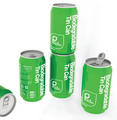


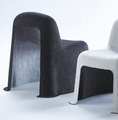




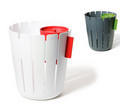
Comments by our Users
Be the first to write a comment for this item.